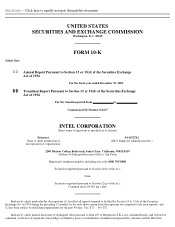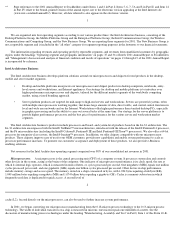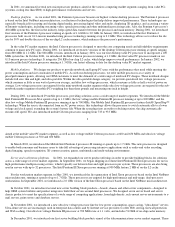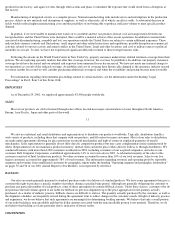Intel 2001 Annual Report Download - page 12
Download and view the complete annual report
Please find page 12 of the 2001 Intel annual report below. You can navigate through the pages in the report by either clicking on the pages listed below, or by using the keyword search tool below to find specific information within the annual report.
Our goal is to be the preeminent building block supplier to the worldwide Internet economy. Our primary focus areas are the desktop,
mobile and server platforms, and networking and communications platform including wireless communications, as well as new business
opportunities around the Internet. In each of these market segments, we compete, to various degrees, on the basis of functionality, performance,
quality, price and availability. We are engaged in a rapidly advancing field of technology in which our ability to compete depends on our
ability to improve our products and processes, develop new products to meet changing customer requirements and reduce costs. Prices decline
rapidly in the semiconductor industry as unit volumes grow, further competition develops and production experience is accumulated. Many
companies compete with us in the various computing, networking and communications market segments, and are engaged in the same basic
fields of activity, including research and development. Worldwide, these competitors range in size from large multinational companies to
smaller companies competing in specialized market segments.
The Intel Architecture business consists of the Desktop Platforms Group, the Mobile Platforms Group and the Enterprise Platforms Group.
Our strategy for the desktop and mobile platforms is to introduce ever-higher performance microprocessors and chipsets, developed for
different market segments of the worldwide computing market, using a tiered branding approach. Our strategy for the server platform is to
provide higher performance processors and the best price for performance for the
12
various market segments. In line with our strategies, we seek to develop higher performance microprocessors based on the Intel NetBurst
microarchitecture specifically for each computing market segment.
Our financial results are substantially dependent on sales of microprocessors by the Intel Architecture operating segment. A number of
competitors market software-compatible products intended to compete with Intel architecture-based processors. We also face significant
competition from companies offering rival microprocessor architectures. The Celeron processor competes with existing and future products in
the highly competitive value PC market segment. The Pentium 4 processor competes with existing and future products in the performance
desktop and entry-level workstation market segment. The Mobile Intel Pentium 4 processor competes with existing and future products in the
mobile computing market segment. We have experienced an increase in the competitive product offerings in the performance desktop market
segment and recently in the mobile market segment. The Pentium III Xeon processor based on the P6 architecture and the Intel Xeon processor
based on the Intel Netburst architecture compete in the mid-range and high-end server and workstation market segments. The Intel Itanium
processor competes in the enterprise-class server market segment. These three processors all compete with established products based on rival
architectures.
Many of our competitors are licensed to use our patents. Furthermore, our competitors can design competing products and avoid our
patent rights by using certain foundry services that have broad licenses with us that, under current case law, permit them to pass our patent
rights on to others. Competitors' products may add features, increase performance or sell at lower prices. We cannot predict whether our
products will continue to compete successfully with such existing rival architectures or whether new architectures will establish or gain market
acceptance or provide increased competition with our products. Future distortion of price maturity curves could occur if software-compatible
products enter the market segment in significant volume or alternative architectures gain market acceptance.
We plan to cultivate new businesses as well as continue to work with the computing industry to expand Internet capabilities and product
offerings, and develop compelling software applications that can take advantage of higher performance microprocessors and chipsets,
increasing demand for Intel's newer products in each computing market segment. We may continue to take various steps, including reducing
microprocessor prices and/or offering rebates and other incentives at such times as we deem appropriate, in order to increase acceptance of our
latest technology and to remain competitive within each relevant market segment.
In the Intel Communications Group, our strategy for the networking and communications platform is based on three focus areas: Ethernet
connectivity, optical components and network processing components. In the these areas, we face competition from both established and
emerging companies and competitors use aggressive product and acquisition plans in an effort to achieve leading-edge market positions. Our
products also compete in the small and mid-sized enterprise market segments with established products and leading edge Internet
communications systems and server products. We cannot predict whether our networking and communications products will continue to
compete successfully with products from existing competitors or products from new entrants to these market segments.
In the wireless communications business, our strategy is to deliver complete solutions that enable quick deployment of applications and
services for wireless Internet and personal information devices. For these segments, we offer flash memory products, processors based on the
Intel StrongARM processor and Intel Xscale™ microarchitecture and baseband chipsets. In supplying these products, our Wireless
Communications and Computing Group faces competition from the products of established companies in the flash memory market segment.
We cannot predict whether our products will continue
13
to compete with existing competitors in the flash memory market segment and compete with new entrants in the applications processor and
























